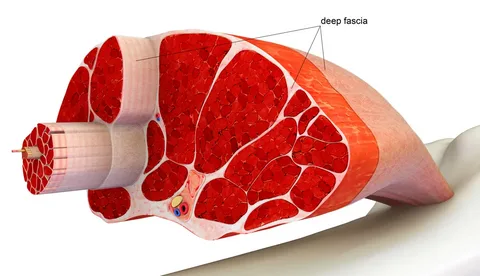In the pursuit of a fit and healthy body, we often focus on exercising our muscles, improving bone health, and reducing fat. However, an integral part of our anatomy is often neglected – our fascia. Fascia is a thin casing of connective tissue, primarily composed of collagen, that provides strength and protection to various parts of our body. It surrounds and holds organs, blood vessels, bones, nerve fibers, and muscles in place. Fascia has been gaining recognition for its crucial role in muscle and bone health.
Although fascia is not easily visible in the body, it can be understood by observing the thin white streaks on the surface or between layers of a steak. Fascia serves both general and specialized functions in the body and is organized in different layers. The superficial fascia lies beneath our skin, between layers of fat, while the deep fascia covers muscles, bones, and blood vessels.
Recent studies have emphasized the link between fascia, muscle, and bone health and function. It has been discovered that fascia plays a vital role in muscle contraction, assisting muscle cells in generating force and influencing muscle stiffness. Each muscle is enveloped in fascia, enabling adjacent muscles to move freely without interfering with each other’s function. Fascia also facilitates the transmission of force through the musculoskeletal system, such as the transfer of force from the Achilles tendon to the plantar fascia in the foot.
Impaired fascia function, often due to injury, can hinder movement and force transmission between layers, leading to a prolonged recovery process. Additionally, recent research has revealed that fascia, especially the superficial layers, contains a significant number of nerves, ranking second only to the skin. The fascial linings of muscles have been associated with pain stemming from surgery, musculoskeletal injuries, exercise, and aging. It is estimated that up to 30% of individuals with musculoskeletal pain may experience fascial involvement.
In response to the growing awareness of fascia’s significance, various treatment approaches have emerged. Fascial manipulation, a type of massage developed by Luigi Stecco, has shown positive results in relieving pain from conditions like patellar tendinopathy and chronic shoulder pain. Kinesio tape, frequently used in professional sports, is also being utilized to complement fascial function and treat chronic lower back pain.
In addition to its rehabilitation potential, fascia can also be a pathway for infections to travel within the body. Normally, the spaces between fascial layers are closed, but infections can spread between them, particularly in the neck region where multiple layers of fascia exist. Severe cases may require surgical intervention to remove infected tissue and preserve healthy tissue.
Plantar fasciitis highlights the role of fascia in health and the challenges that arise when dysfunction occurs. This common condition affects 5-7% of the population and up to 22% of athletes, resulting in thickening of the fascial bands that provide arch support in the soles of the feet. Fascia can also be involved in more serious health conditions, such as necrotizing fasciitis, a potentially fatal bacterial infection that spreads quickly through the body via the fascia.
Historically, fascia has often been overlooked due to limitations in imaging technology. However, advancements in MRI and ultrasound imaging have enabled visualization of fascia, particularly in musculoskeletal conditions like plantar fasciitis, as well as pathological changes in the fascia of the shoulder and neck.
As interest in fascia grows and our understanding of its role in musculoskeletal health deepens, it becomes imperative to prioritize its care alongside other components of the musculoskeletal system. Simple techniques like foam rolling and stretching can enhance fascial mobility, but there is still much to learn about the intricacies of fascia and its impact on our overall well-being.



